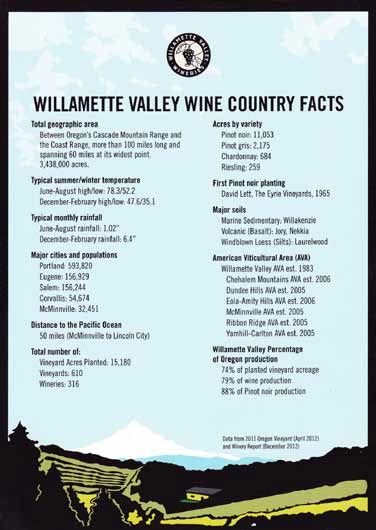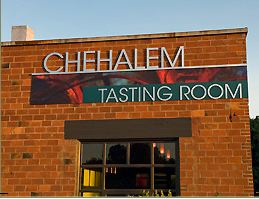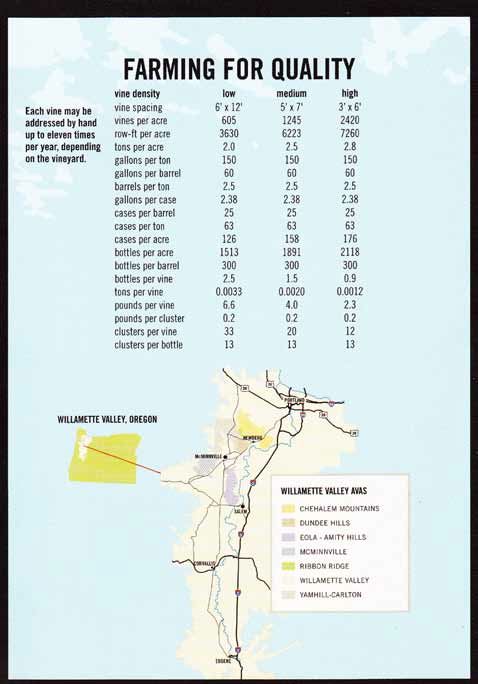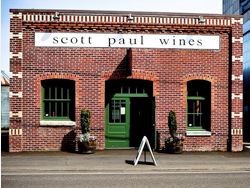Pinot Noirvana in the Willamette Valley
I just returned from a week in Oregon’s Willamette Valley, visiting many wineries and tasting the Pinot Noirs
from the 2011 and 2012 vintage. I timed my visit perfectly as it was sunny and warm all week, a freakish
weather event in this region that is usually under a dismal rain cloud almost every day this time of year.
The Willamette Valley wine country is truly a retro experience with wineries eager to receive you, offering wines
of uncommon excellence by people who are truly friendly, dedicated and unpretentious. I like to say that
Willamette Valley Pinot Noirs are genuine wines by genuine people. Beards, plaid flannel shirts and worn
denims are de rigueur in the Willamette Valley, the roads to the wineries are often paved with dirt or gravel and
surrounded by fields of grain and grass, and sparsely populated with muddy pickup trucks and old tractors. It is
quite a contrast in lifestyle to the one in Orange County, California, where I live.
Vintners in Oregon are not into Pinot Noir for the money because the production of high-end Pinot Noir is not a
particularly financially rewarding proposition. Yields are purposely kept low, grape growing is labor intensive,
and with well over 350 wineries, competition is fierce. Yet the Oregon vintners have persevered for fifty years,
driven by a passion that only a pinotphile can appreciate.

In the Willamette Valley there is really no equal to the glorious Napa Valley chateau winery experience (think
Darioush, Castello di Amorosa). Even the most modern and largest wineries such as Domaine Serene, Sokol
Blosser and Willamette Valley Vineyards do not seem out of place in the Willamette Valley farmland. Most
other wineries are in secluded mountainous sites reachable only by winding, rutted roads that challenge your
GPS, and the tasting may be conducted in the owner’s kitchen or back patio. Yet, the owner’s reception is
warm and welcoming, and the wines are authentic, offering those who spend the effort to seek them out an
exceptional wine drinking experience.
Over the past few years, looking to make their wines more accessible, a number of wineries have opened
tasting rooms clustered in the towns of Carlton and Newberg. In Carlton, DePonte has opened a contemporary
tasting room in the town’s old fire station next door to the excellent Carlton Bakery. Among the other twenty
tasting rooms in Carlton, all within walking distance, are Carlton Cellars, Scott Paul, Ken Wright Cellars,
Kramer Vineyards, Lachini Vineyards, Noble Pig Vineyard & Winery, Omero Cellars, Scott Paul Wines, Seven
of Hearts/Luminous Hills, Siltstone Wines Twelve Wine and WildAire Cellars. Carlton Winemakers Studio is
close by. For more tourism information on Carlton, consult www.visitcarlton.com.

There are eleven tasting rooms within walking distance in downtown Newberg including Anam Cara, Artisanal
Wine Cellars, Chehalem, Dark Horse Wine Bar (Medici Vineyards, Sineann Winery), Fire + Flood, Fox Farm
Vineyards, and Longplay Wine. For more information on Newberg, visit www.newbergdowntown.org.
Why visit the Willamette Valley and seek out the local Pinot Noir? The wines are often considered the closest
thing to Burgundy in North America, offering low to modest alcohol, juicy fruit flavors, elegance and vivid acidity.
This is not surprising because the Willamette Valley is situated at the same longitude as Burgundy and the
growing season has many similarities. There is a dedicated commitment in the Willamette Valley to farming for
quality and this is shown by the figures below compiled by the Willamette Valley Wineries Assocation.

Most of the Pinot Noir now being offered from Willamette Valley producers are from the 2011 and 2012
vintages. In 2011, spring and early to mid summer weather was cool and wet. More than 250 minimum
temperature records were broke during that period and over 400 precipitation records were exceeded. Bloom
in the Willamette Valley was in July! The season turned around in September, which was one of the three
warmest Septembers on record in Oregon. The fruit ripened and it was termed a “miracle harvest.” Most
grapes were brought in under warm, sunny skies and there were only modest issues with birds and botrytis.
Some vineyards were picked as late as the first week of November.
Many have said that the cool 2011 vintage brought Oregon back to its roots, showing a classic Pinot Noir
profile of lower alcohol, bright acidity and consuming elegance that made Oregon Pinot Noir famous. The wines
have tended to be more austere and lean upon release, and many vintners have likened the vintage to 2007,
when the wines were not charming upon release, but developed weight, intensity and nuance after a year or
two in bottle. For these reason, some Willamette Valley vintners told me they held back the 2011 vintage wines
before release only recently offering them for sale. Some vintners were seriously considering releasing the
more forward, flashy 2012 Pinot Noirs and pulling the 2011 Pinot Noirs back for another year of aging. Many
winemakers I spoke with preferred the 2011 vintage Pinot Noirs over the 2012 wines because of their more
classic Pinot Noir style. Steve Lutz of Lenné Estate told me, “They are not very developed on the nose or
palate yet, but every time I sit with them, I see promise and they really capture me after I have had them open
for a day or two. The 2007 vintage turned out to be one of my favorites even though the wines started out quite
lean, very similar to the 2011 wines.”
There has been considerable hype about the 2012 vintage Pinot Noirs which are fruit-forward, plush and
reminiscent of the 2006 vintage in Oregon. Many have declared the 2012 vintage as one of the greats in
Oregon history. Bud break was a week later than normal, but weather was normal during bloom with minimal
rainfall towards the end of flowering. Reduced berry set led to lower yields than the 2011 vintage. The growing
season was warm and dry resulting in very low disease pressure and ripening was ideal until harvest. The only
hitch was a week of warm easterly winds in September that pushed grape sugars up.” Many wines are over
14% alcohol and full-bodied with lush fruit flavors reminiscent of California Pinot Noir. That said, it is a
consumer’s vintage and most will embrace the early drinking and hedonistic wines. Many of the 2012 Pinot
Noirs are being released during the annual Memorial Weekend in the Wine Country sponsored by the
Willamette Valley Wineries Association (www.willamettewines.com).
In the following pages of this issue, I will review my week in the Willamette Valley and the many wines I tasted.
The consistent high quality of the wines really stood out. No matter whether one prefers the 2011 or 2012
wines, the Pinot Noirs are world class. One thing I have observed about Oregon vintners is that they are a bit
shy about tooting their own horn. They have had a long and beneficial association with Burgundy vignerons,
and are reticent to claim any superiority of their wines over their French counterparts. The truth is, their best
wines rival anything currently produced in Burgundy and the general consistency is something that must make
Burgundy green with envy. I believe investing in a premium bottle of Willamette Valley Pinot Noir (say $50-
$100) is a safer bet than spending an equivalent amount of money on a red Burgundy.
According to Wines & Vines (April 2014), experts at this year’s Oregon Wine Symposium noted that Oregon
DtC shipments of Pinot Noir have prospered of late and the latest figures show that Oregon wines account for
3.6% of the domestic wine shipped DtC (54% of which is Pinot Noir) The average bottle price of about $15.40
was higher than California, Washington or imported wines. Interestingly, a survey by Wine Opinions conducted
of regular wine drinkers in January 2014, showed that although 44% of Oregon respondents reported buying
more Willamette Valley Pinot Noir, the statistics lagged way behind California where 86% of Pinot Noir fans
reported drinking California Pinot Noir.
If you get the urge to visit Oregon’s Willamette Valley, you will find it is easy to access. A 45-minute drive from
Portland’s International Airport will put you right smack in the center of the Willamette Valley and close to
hundreds of desirable Pinot Noir producers. The best time to visit to avoid the incessant rain is July, August
and September, which are dry months in the Willamette Valley, but other times in the fall and spring are
appealing because of the lack of tourists. The Allison Inn & Spa in Newberg is centrally located and offers all
the comforts of a world-class hotel in Oregon’s wine country. There are many B&B’s and vacation homes as
well, all scattered throughout the Willamette Valley and offering warm hospitality, particularly Le Puy, A Wine
Valley Inn, also in Newberg.
To plan your trip, visit the Willamette Valley Wineries Association and secure their brochure, “Guide to
Willamette Valley Wineries: Drink Pinot Think Oregon.” Other useful websites include Oregon Wine Board at
www.oregonwine.org, Travel Oregon at www.traveloregon.com, and the individual AVA websites such as
www.chehalemmountains.org, www.dundeehills.org, www.eolaamityhills.com, www.mcminnvilleava.org, and
www.yamhillcarlton.org. On Memorial Day and Thanksgiving weekends, all wineries in the Willamette Valley
are open to visitors. May is Oregon Wine Month and wineries are hosting special events during the entire
month: visit www.willamettewines.com/oregon-wine-month/. You can contact me at prince@princeofpinot.com
and I will assist you in arranging private and attentive visits to many wineries in the Willamette Valley. I can
also recommend the best lodging and dining options. If you go, remember that the locals pronounce it
Willamette, as in dammit!
Don't be alarmed, this is not the last article in this issue! I have decided to release each issue of The PinotFile in stages much like a blog rather than publish the issue in its glorious entirety once every 3 weeks. Every 2 to 3 days another article will be posted until the entire issue is completed at which time subscribers will receive notice that the entire issue is posted. Those that subscribe to the Twitter or RSS feed will be notified when each article of an issue is published online, usually every 2 to 3 days. This way, the information can be relayed in a more timely manner and requires only a few minutes to peruse. You may download in pdf format each article or the entire issue when it is completed. Please let me know if you like this new staged format at prince@princeofpinot.com.






